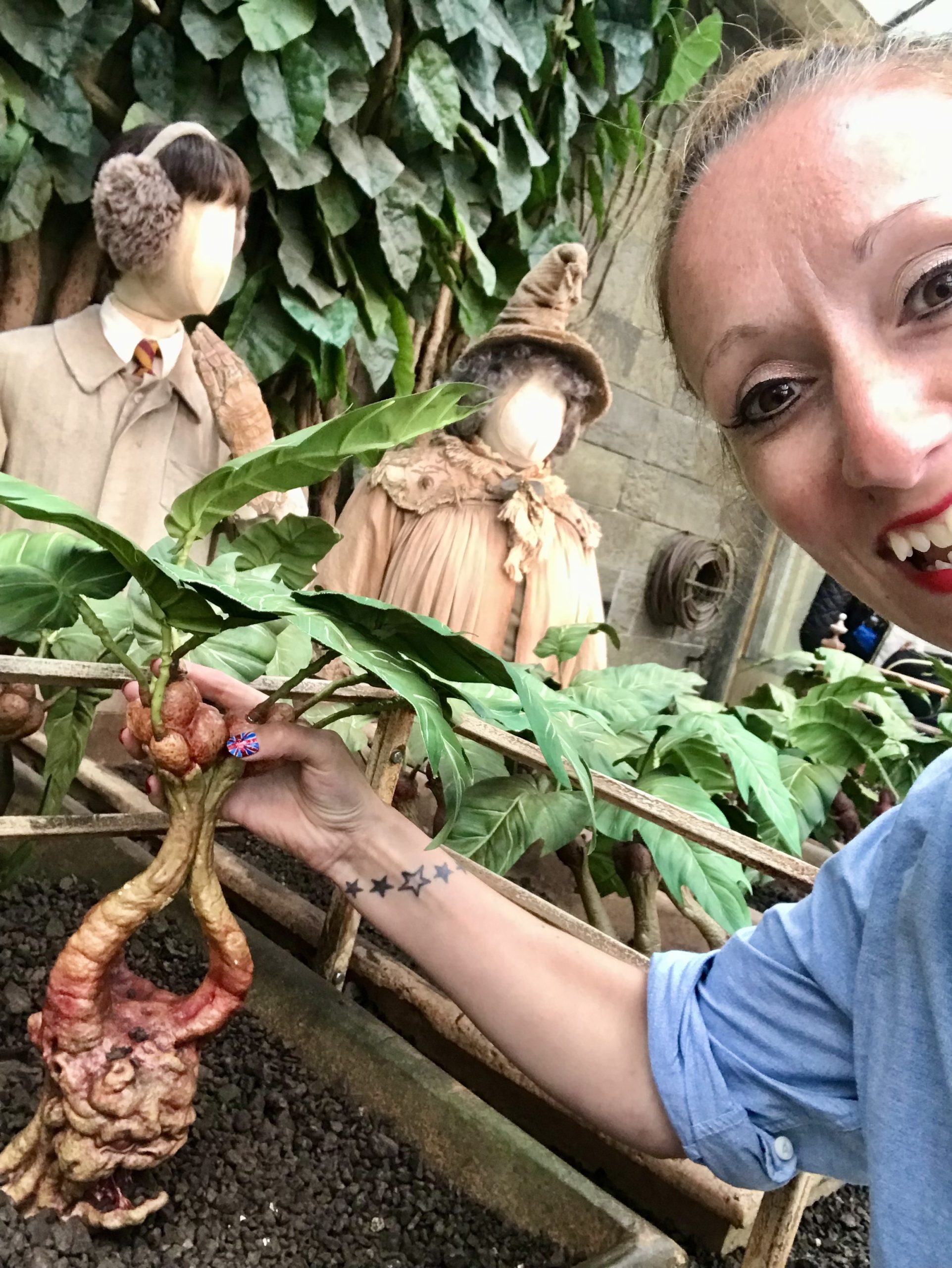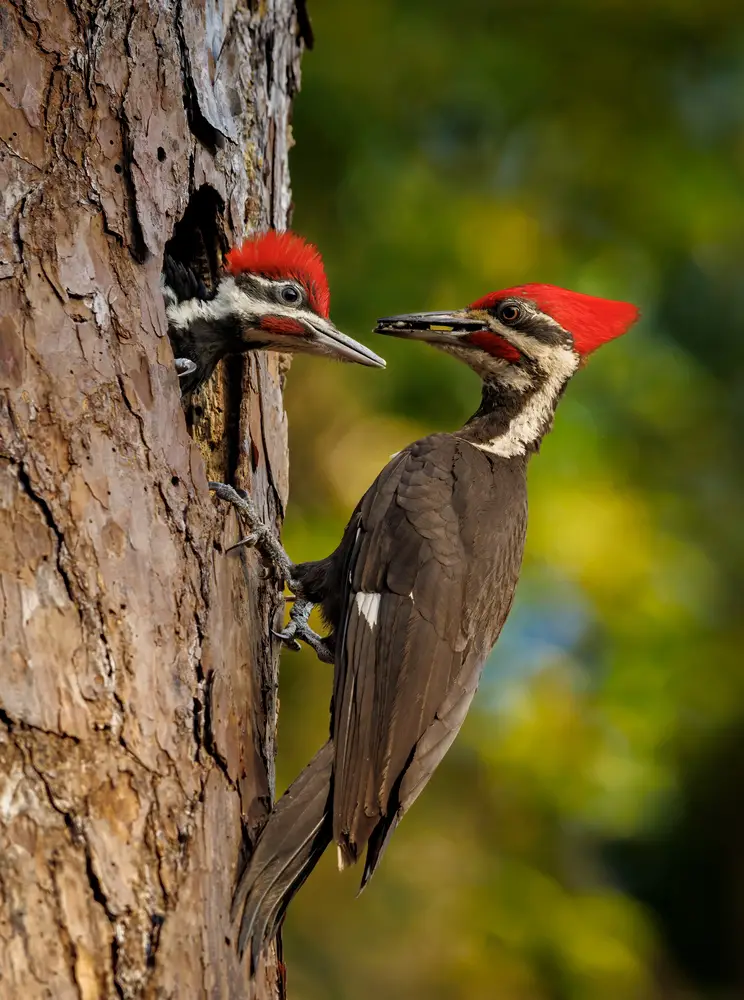From the largest, stately Pileated Woodpecker to the smallest cute, little Downy Woodpecker, all woodpeckers are magnificent birds to behold.
There are approximately 240 different species of woodpeckers worldwide with a diverse range living in the United States to captivate any bird enthusiast!
In this article, we’ll tell you all you need to know – including habitat, behavior, and viewing tips – about the wonderful woodpeckers in Wisconsin!
Habitat And Distribution
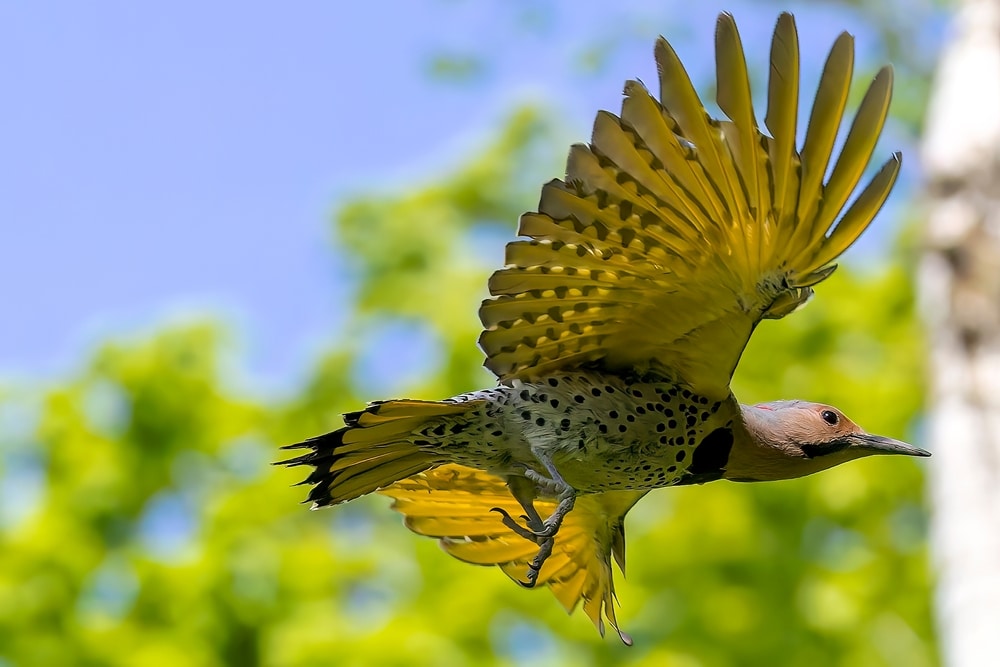
There are many types of woodpeckers in this area and they can be found in a variety of habitats. This makes the state a great place to observe these fascinating birds.
Woodpecker Habitats In Wisconsin
Wisconsin’s woodpeckers favor various environments, including;
- Deciduous forests
- Mixed woodlands
- Even urban parks with mature trees
Woodpeckers typically prefer habitats with a mix of live and dead trees, which provide both food and nesting sites.
Decaying trees and snags are particularly important as they offer the insects that woodpeckers feed on and serve as ideal woodpecker nesting sites in Wisconsin.
Wisconsin Woodpecker Migration Patterns
Regarding migration patterns, some woodpeckers are year-round residents in Wisconsin, while others may move to different areas depending on seasonal food availability and weather conditions.
Common woodpeckers, such as the Downy Woodpecker, Hairy Woodpecker, and Pileated Woodpecker can be seen throughout the year, while others might migrate seasonally. For example, the Yellow-bellied Sapsucker might migrate to southern regions in winter.
Where To Find Woodpeckers In Wisconsin

To find woodpeckers , next time you are walking in forested areas or parks with large trees, listen out for their distinctive drumming sounds on trees.
Keep an eye out for their nesting sites, which are usually found in dead or decaying trees where they excavate cavities.
Don’t forget to watch where you are walking as you might scare up a Northern Flicker who is foraging in leaves on the ground!
Places where you might spot woodpeckers in Wisconsin are:
- Wisconsin Point
- The Chequamegon National Forest
- The Horicon Marsh State Wildlife Area
- The Kettle Moraine State Forest
- The Northern Highland-American Legion State Forest
- Wyalusing State Park
- Schlitz Audubon Center
- The University of Wisconsin Arboretum
- Trempealeau National Wildlife Refuge
- Sandhill Wildlife Area
- Lake Superior/North Woods Birding and Nature Trail
- Other regions with abundant mature woodland
By visiting these habitats and observing their behaviors, you can gain insight into the lives of these remarkable birds.
Woodpecker Behavior And Characteristics
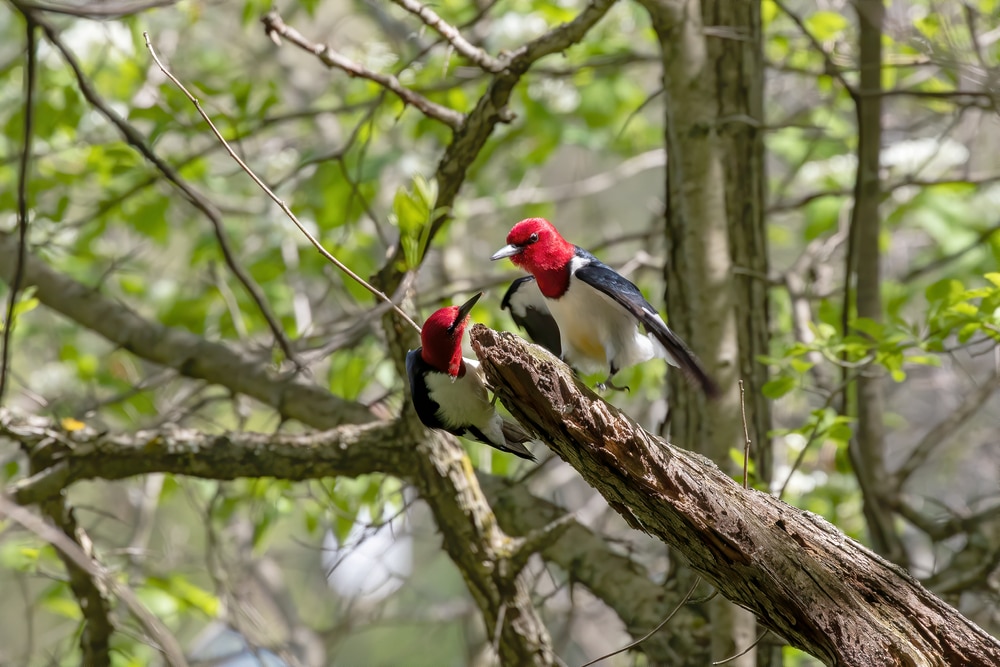
You may have been out on a scenic hike and heard woodpecker drumming sounds in Wisconsin. Their distinctive drumming sounds are not only a way to search for food but also play a key role in woodpecker communication, establishing territory, and attracting mates.
Woodpeckers’ behavior during winters is relatively consistent, although they may rely more on feeders and stored food as the insect populations decline.
Despite the colder temperatures, they persist in their foraging behavior and continue their characteristic drumming and communication. This ensures their survival and reproductive success even in challenging conditions.
Woodpecker Sounds And Communication
Woodpeckers use vocalizations, such as calls, and drumming to communicate.
Woodpecker calls vary by species. A Pileated Woodpecker drumming sound is very distinctive – it sounds like a pneumatic drill!
Other woodpecker sounds you might hear are the lighter and chattier notes of species such as Red-bellied and American three-toed.
During the mating season, woodpeckers’ mating rituals include rhythmic drumming and (often very noisy!) vocalizations to communicate with potential partners and strengthen pair bonds.
This vocal communication continues throughout the year, helping them maintain their territory and coordinate with mates.
Diet Of Wisconsin Woodpeckers
Have you ever wondered: What do woodpeckers eat? Well, read on, we’ve got you covered for all you need to know about woodpecker feeding habits!
Woodpecker diet depends on the species as well as the season but in general, most woodpeckers enjoy eating the following:
- Insects and Larvae: this makes up the bulk of their diet. They use their strong beaks to drill into wood and bark to find these insects, such as beetles, ants, termites, and wood-boring larvae.
- Sap: Many types of woodpeckers, such as yellow-bellied sapsuckers feed on tree sap. They create holes in the tree with their beaks so they can access the sap.
- Fruits and Nuts: Woodpeckers also eat fruits, berries, and nuts, especially during seasons when insects are less available. For example, red-headed woodpeckers store nuts and seeds in tree crevices to eat later.
- Seeds: Woodpeckers often eat seeds during seasons when their favored food source of insects is scarce.
- Suet: Add suet to your feeders to attract woodpeckers! It’s a great high-energy food for them during the colder months.
Woodpeckers And Their Role In Ecosystems
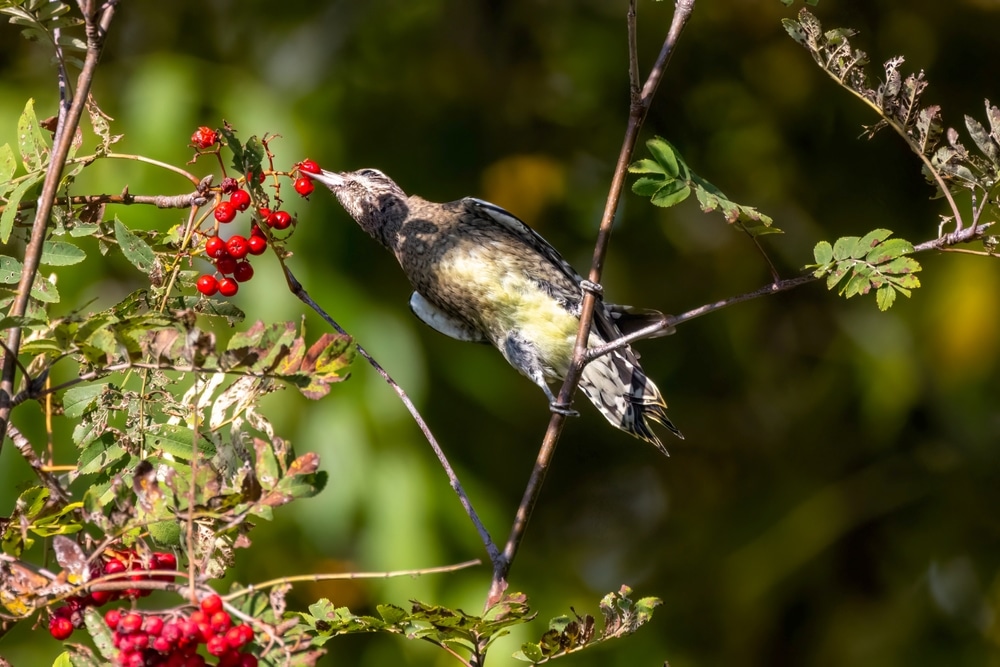
Woodpeckers’ ecological role is vital to ecosystems, contributing significantly to the health and balance of their environments.
The impact of these birds on ecosystems in Wisconsin and beyond has various benefits, including:
- Insect Control: Their foraging behavior helps control insect populations, as they feed on pests that can damage trees and plants.
- Biodiversity: Woodpeckers create nesting cavities in trees, which are then used by a variety of other wildlife species, thus promoting biodiversity.
- Soil Health: By drilling into trees to find food, they also aid in the decomposition process, enriching the soil with nutrients.
Overall, the benefits of these birds extend beyond their immediate feeding habits, supporting a diverse range of species and contributing to ecosystem stability.
Woodpecker Conservation and Protection
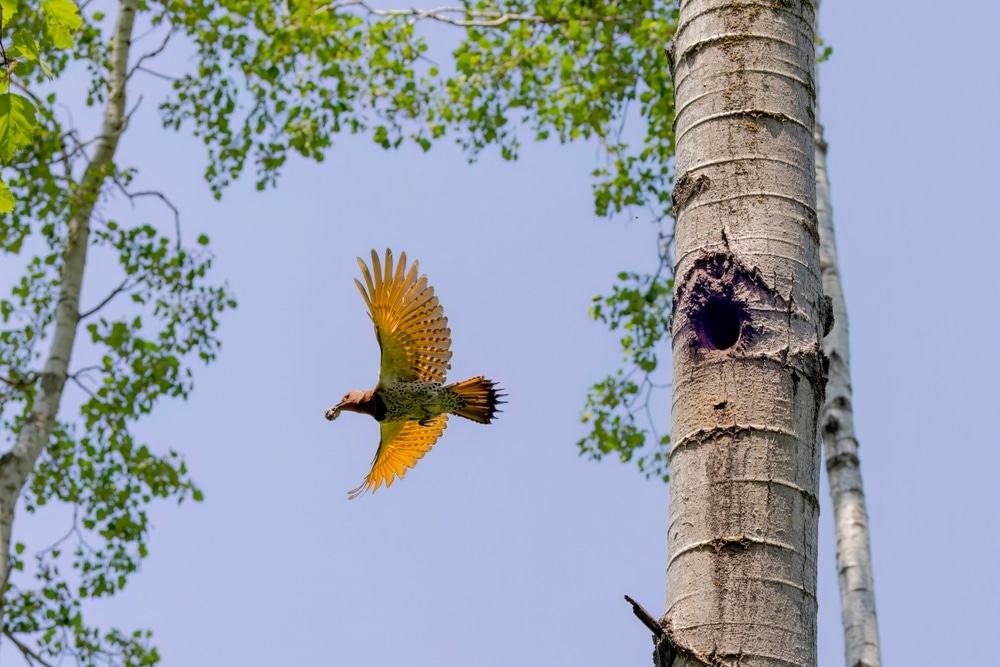
Woodpecker conservation and protection are crucial for maintaining the health of ecosystems in Wisconsin. Threats to woodpeckers include:
- Deforestation
- Climate change
- Loss of habitat
- Vehicle-caused mortality
Woodpecker conservation efforts in Wisconsin focus on preserving natural habitats, which are vital for the survival of the state’s various woodpecker species.
The Red-headed Woodpecker is an endangered woodpecker species in Wisconsin. This beautiful bird is a Special Concern species in the state
Woodpecker conservation in Wisconsin involves:
- Protecting Wisconsin’s biodiversity
- Habitat protection and restoration
- Public awareness
- Mitigating the impacts of environmental threats
These are much-needed efforts to ensure these remarkable birds continue to thrive in their natural environments.
How To Attract Woodpeckers To Your Yard
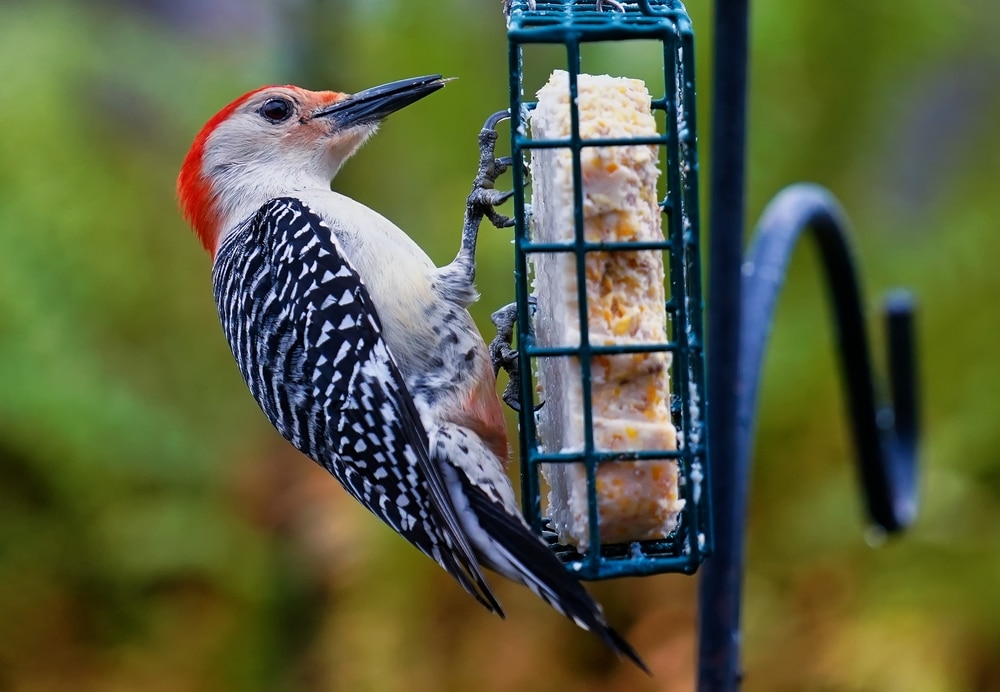
Attracting woodpeckers to your yard is a rewarding way to enjoy these beautiful birds and support local wildlife.
Here are some tips to get you started:
Provide Feeders
To attract woodpeckers to your yard, install specialized feeders designed to hold suet, a high-energy food source that woodpeckers need. Suet feeders are particularly effective for this purpose.
Native Plants
Incorporate woodpecker-friendly plants into your garden, such as native trees and shrubs that produce berries and seeds.
Offer natural food sources and suitable habitats to attract these fascinating birds.
Go Natural
In Wisconsin, trees like oak and birch are particularly beneficial. Creating a woodpecker-friendly backyard also involves providing dead or decaying trees, as these serve as important foraging and nesting sites. So don’t be too quick to clean up!
By combining these woodpecker-friendly backyard ideas, you can create an inviting environment that supports woodpeckers and enhances your backyard’s ecological value.
Woodpecker Watching Tips
Here are some woodpecker spotting tips to enhance your chances of woodpecker sightings in Wisconsin.
Location: For the best places to see woodpeckers visit wooded areas, forests, and parks where these birds are commonly found.
Timing: Early mornings and late afternoons are the best times for woodpecker watching, as woodpeckers are most active during these periods.
Sounds: Listen for their drumming sounds, which can help you locate them. They use these distinctive pecking noises to communicate and forage for food.
Signs: Look for holes in trees or wood chips on the floor below trees. It’s a good sign that a woodpecker is about!
Flight: Woodpeckers have a distinct undulating flight pattern. This makes them easy to spot in the skies.
Viewing: Make sure to bring binoculars so you can get a close-up of their striking colors and patterns.
Take Your Time: Patience is key with any birdwatching. Woodpeckers are sometimes elusive and require quiet observation. But they are worth the wait!
Guides & Apps: Consider using local field guides or birding apps to help with woodpecker species identification in Wisconsin. They are very useful if you want to identify different woodpecker and learn more about their habits and calls. I never do any birding without my trusty Merlin Bird ID App!
Wisconsin Woodpecker Species
Here’s our top Woodpecker Species List :
Pileated Woodpeckers
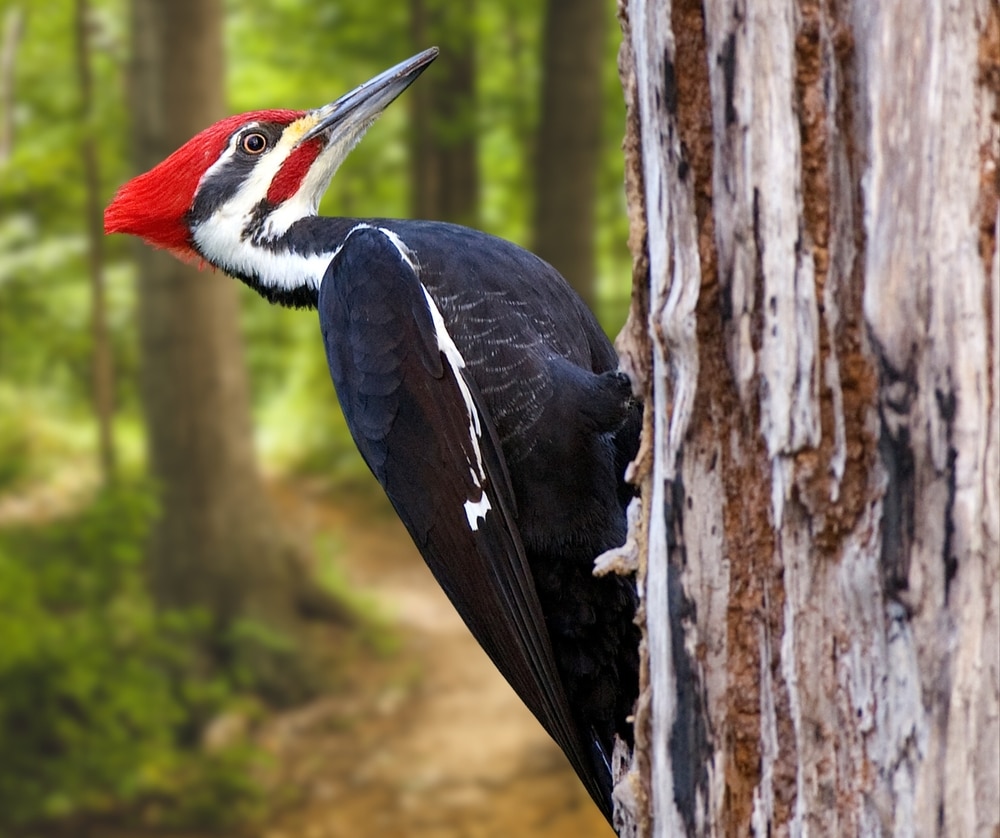
| Name | Dryocopus pileatus |
| Height | 15.8-19.3 inches (40-49 centimeters) |
| Wingspan | 26-29.5 inches (66-75 centimeters) |
This is the largest woodpecker you will find in Wisconsin. With a massive 26-29.5 inches (66-75 centimeters) wingspan, you are sure to notice a Pileated woodpecker if it flies by you!
These almost prehistoric-looking birds are mainly black with white stripes on the face and white patches on the underwings. Their distinctive bright-red crest sweeps back on their head.
Pileated woodpeckers have very loud calls and make pronounced drumming sounds.
If you notice large rectangular holes in trees, likely a pileated woodpecker has been there.
Their favorite feast is carpenter ants but they also eat:
- Wood-boring insects
- Other ants
- Berries
- Fruit
- Suet
They are known to visit feeders. So, put a suet feeder out in your backyard if you are keen to view these majestic birds.
Downy Woodpeckers
| Name | Picoides pubescens |
| Height | 5.5-6.7 inches (14-17 centimeters) |
| Wingspan | 9.8-11.8 inches (25-30 centimeters) |

The Downy Woodpecker is the smallest woodpecker you will find in Wisconsin.
These little birds are black and white. They have a clear white stripe down their backs and white spots on black wings. Males feature a red spot on the back of their heads.
Despite their small size, they have powerful beaks that they use to excavate trees for insects. They also like to eat fruit, seeds, and suet. They are frequent visitors to backyard feeders.
Hairy Woodpeckers
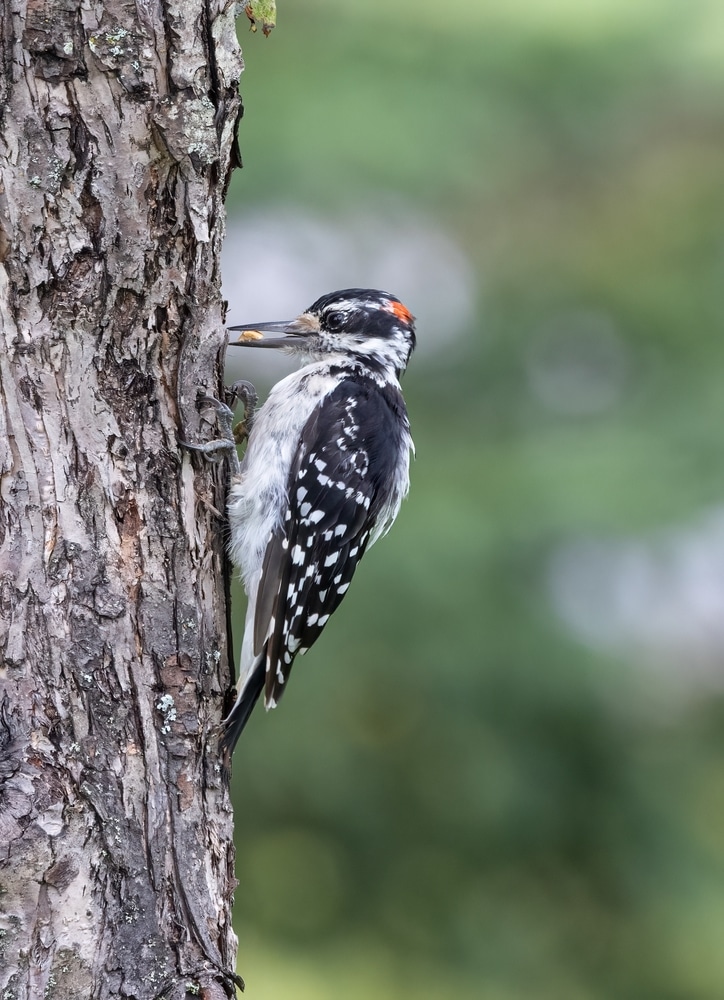
| Name | Picoides villosus |
| Height | 7.1-10.2 inches (18-26 centimeters) |
| Wingspan | 13-16.1 inches (33-41 centimeters) |
Hairy Woodpeckers are very similar to the smaller Downy woodpeckers. The bill is the key to distinguishing between the Downy Woodpecker and the Hairy Woodpecker has a much larger bill.
- Downy: Short chisel-like bill
- Hairy: Bill is equal in length to its head
Hairy Woodpeckers like to feed on insects, fruit, and seeds. They tend to forage on larger trees.
They are black and white in color, with two white stripes on their faces. Males have a red patch at the nape of their neck.
Like other species of woodpeckers, such as the Black-backed woodpecker, Hairy woodpeckers are attracted to burnt or dying trees.
Red-Headed Woodpeckers (species of concern)
| Name | Melanerpes erythrocephalus |
| Height | 7.5-9.1 inches (19-23 centimeters) |
| Wingspan | 16.5 inches (42 centimeters) |
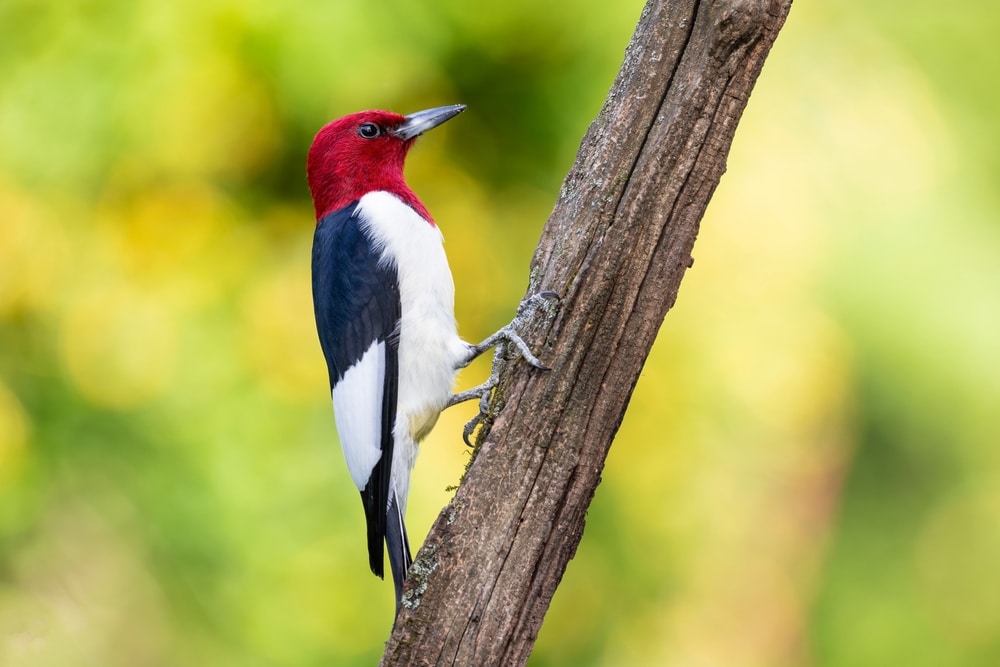
Now these are really spectacular-looking birds! They have a white body, half-white and half-black wings, and a striking crimson-red head. Spotting this woodpecker is a treat for any birder.
Red-headed woodpeckers are unique in their acrobatic feeding habits. They often hunt and catch insects mid-air!
Unfortunately, they are a “Special Concern” species in Wisconsin. So, make sure to leave all habitats undisturbed.
They like to eat a variety of food including:
- Insects
- Nuts
- Seeds
- Fruit
They also store food (seeds and nuts) in tree crevices and save them for later!
Red-Bellied Woodpeckers
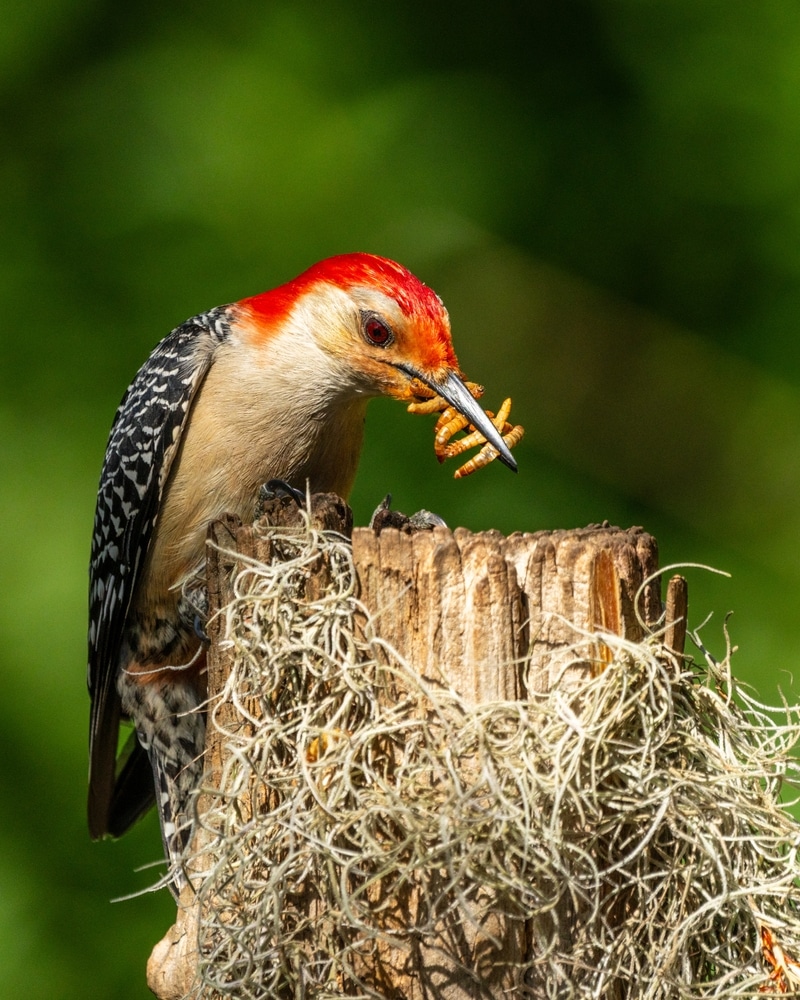
| Name | Melanerpes carolinus |
| Height | 9.4 inches (24 centimeters) |
| Wingspan | 13-16.5 inches (33-42 centimeters) |
This species has a very striking appearance. They are pale underneath, have beautiful black and white barred wings, and a bright red cap and nape
Red-bellied Woodpeckers like to eat insects, suet, seeds, fruit, and nuts. This species will visit your feeder, so make sure to leave out some tasty treats for them.
They can stick their tongues out 2 inches from the end of their beaks!
Yellow-Bellied Sapsucker
| Name | Sphyrapicus varius |
| Height | 7.1-8.7 inches (18-22 centimeters) |
| Wingspan | 13.4-15.8 inches (34-40 centimeters) |
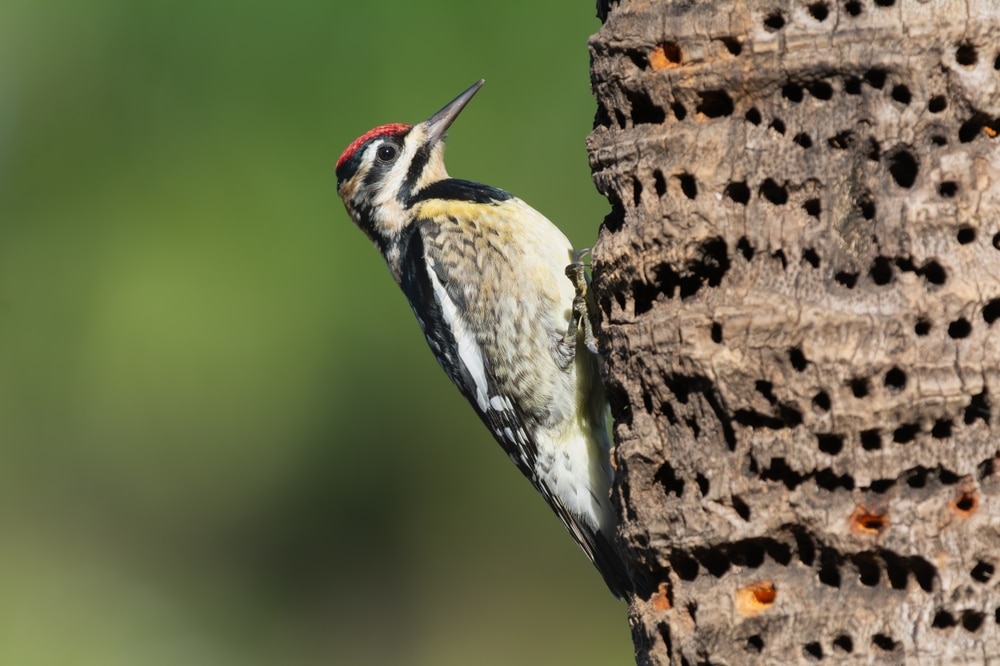
On the smaller side, yellow-bellied sapsuckers are black and white. They have strong black and white stripes on their faces. Both males and females have bright red foreheads and males also have a red throat. They have white or pale yellow bellies, hence their name.These are migratory woodpeckers in Wisconsin.
Makes shallow holes to access tree sap. Also makes deeper holes for insects and beetles. These birds like to visit young birch and maple trees.
Hummingbirds will use the holes (sapwells) that Yellow-bellied sapsuckers make to feed off the tree’s sap! Other birds and animals also use these holes as a food source. These sapsuckers are very beneficial to their ecosystems!
Northern Flicker

| Name | Colaptes auratus |
| Height | 11-12.2 inches (28-31 centimeters) |
| Wingspan | 16.5-20.1 inches (42-51 centimeters) |
NNorthern Flickers are large birds, but not as big as Pileated woodpeckers.
Light brown in color with beautiful black-scalloped barring, these are very attractive birds. They also have a distinctive black crescent on their chests.
There are two types of Northern Flickers which can be distinguished by the color on the underneath of their wings. They are called either “Yellow-shafted” or “Red-shafted.”
- Yellow-shafted flickers are seen more in the East
- Red-shafted flickers are seen more in the West
These are one of the noisiest woodpeckers in Wisconsin! They often drum on man-made material, such as metal, to create louder noises. They use these for communication, mating, and territory.
Often found on the ground foraging for ants and beetles.
Black-Backed Woodpeckers (rare)
| Name | Picoides arcticus |
| Height | 9.1 inches (23 centimeters) |
| Wingspan | 15.8-16.5 inches (40-42 centimeters) |
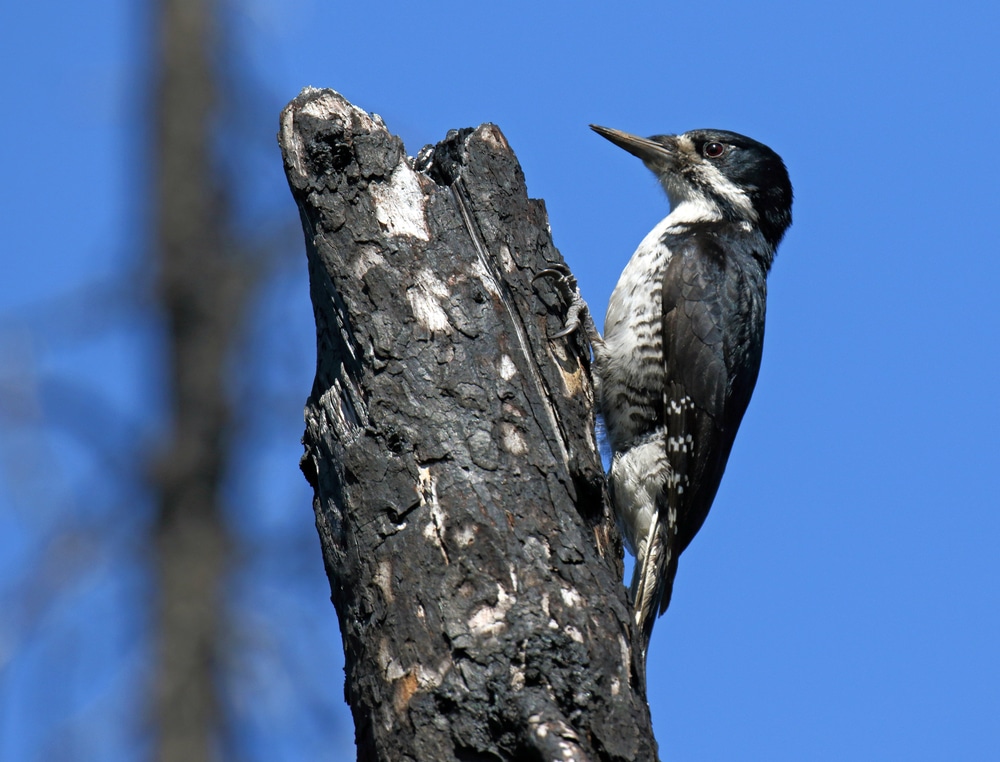
This uncommon woodpecker is distinguished by the lack of a fourth toe. Only 3 species of woodpeckers have 3 toes:
- Black-backed Woodpecker
- American Three-toed Woodpecker
- Eurasian Three-toed Woodpecker
Black-backed Woodpeckers are particularly drawn to areas of recent burns. They camouflage well in charred trees.
These birds have a dark appearance with a black back and upper parts. They also have a white stripe on their face (a “white mustache”) and slight black and white barring on their sides. Males have a prominent yellow patch on their foreheads.
It has a very powerful beak that it uses to excavate for wood-boring larvae and beetles.
This species is known to live in the Chequamegon National Forest, Wisconsin.
American Three-Toed Woodpeckers (rare)
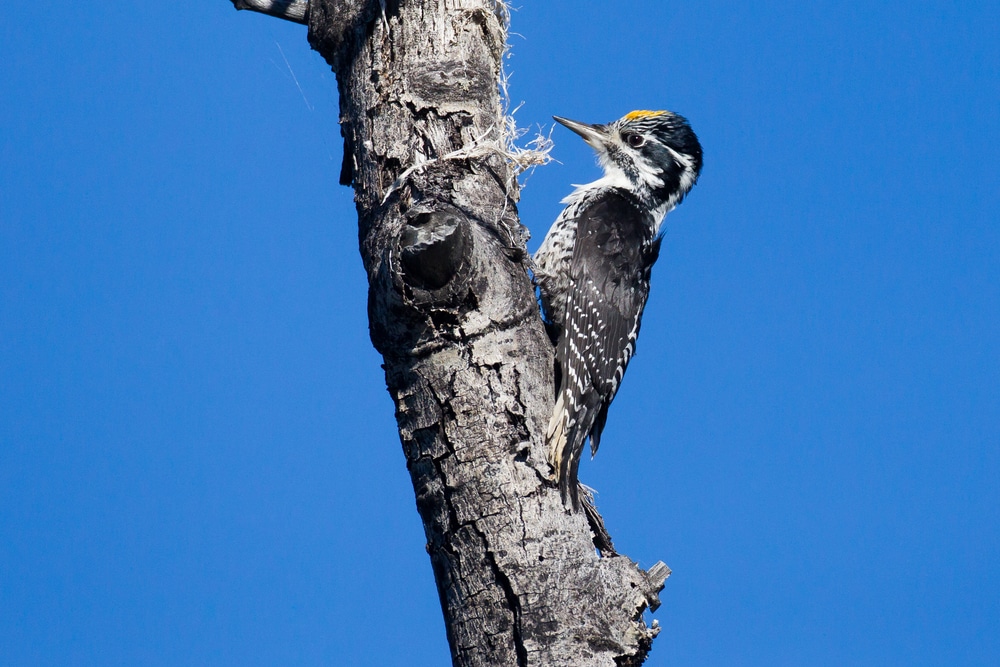
| Name | Picoides dorsalis |
| Height | 8.3-9.1 inches (21-23 centimeters) |
| Wingspan | 14.6-15.3 inches (37-39 centimeters) |
This rare little woodpecker is smaller than the black-backed woodpecker.
It is characterized by the lack of a fourth toe, hence the name. It is suggested that with only 3 toes, it can lean back further and deliver heavier blows to the tree!
Their coloring is black and white with a white stripe down their backs. Males have yellow foreheads.
Rather than boring deeply into the wood they often flake off the bark instead.
American Three-Toed Woodpeckers enjoy a diet of insects, bark beetles, and other wood-boring beetle larvae.
